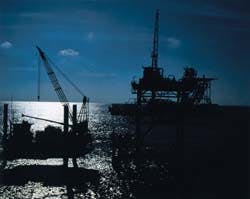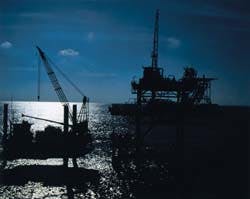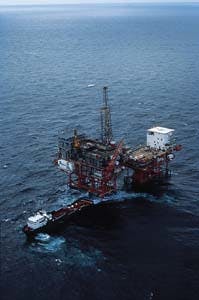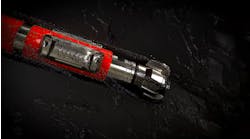COMPLETION TECHNOLOGY Limiting, treating formation damage in horizontal, extended reach wells
In the future, merging of under-balance operations
and coiled tubing may provide alternative to treatment
Formation damage is one of the major reasons for workover operations offshore. (Photo by Bradley Clark)
For years, operators have circulated chemicals downhole to extract materials forced into the formation by drilling operations or to break up the filter cake used to prevent formation invasion. The results have been hugely variable, primarily because of variations in formation chemistry and wellbore position in the reservoir.
Operators want more efficiency from every wellbore and the focus is on differences between test flows through core samples cut from the pay zone and the performance of the well in production. Assuming conditions are modeled correctly, the difference is the limitation imposed by the downhole completion system plus the amount of uncorrected formation damage rendered during the drilling and completion process. Often, the difference is significant.
The major cause of formation damage is drilling fluid. To maintain well control, drilling fluids are circulated under borehole pressures that exceed formation pressures by at least 100 psi and often 200-400 psi. Damage occurs even at the lowest over-balance levels. Formation invasion by fluids and fluid fines are prevented only by low formation permeability and the development of a filter cake. The latter is only effective if it can be created quickly.
One of the attractions to drilling while circulating fluids or gases in an under-balanced condition is to minimize both formation penetration by fluids and formation of a tough filter cake that can be difficult to remove. However, under-balanced drilling requires significant changes in equipment and drilling strategies, in addition to procedures to handle wellbore influx. The process, even the new two-stage procedure where only the target formation is drilled under-balanced, is still a long ways from being adopted offshore.
Meanwhile, drillers and fluid manufacturers continue to experiment with drilling practices, fluid balance, and chemical formulations to both minimize formation skin (pore space blockage or collapse) in the first place and to treat the formation after the damage is done.
In terms of damage prevention, not only do drillers have to watch mud properties and wellbore-formation fluid balance, but also the length of time the formation is exposed to fluid. Exposure time is a much more critical factor in horizontal and extended reach wells than in vertical holes, and this problem is the subject of major ongoing research.
Types of damage
There are a wide range of physical and chemical factors that leave the formation much less permeable to the flow to the flow of oil and gas:
- Mechanical damage: Drill bit rotation downhole leaves in its wake rock compression or stress concentration in the formation near the wellbore (Morales et al). The stress concentration reduces permeability around the borehole, and the damage can extend out as far as three times the borehole radius. The problem appears to occur less in angled wells than vertical holes, largely because the prevalence of natural fractures tends to diminish stress concentrations. Acid cleanup and gravel packing the well are generally ineffective for this type of damage. Hydraulic fracturing with fracture lengths greater than the damaged zone is effective. The process works by dispersing the stresses into the fracture walls.
- Microorganism growth: As in mechanical damage, bacterial activity in the formation is a little noticed but modest influence in limiting permeability. The organisms can be introduced by the drilling or completion fluids, or if already present in the formation, encouraged to multiply by the introduction of certain chemical compounds. The problem with bacterial activity is the production of hydrogen sulfide and carbon compounds, which can react with formation materials to plug pore spaces. Some research was conducted on ways to pressurize the pay zone with bacterial activity, but the risk of loss of permeability in addition to damage to production tubing by hydrogen sulfide has limited interest.
- Hydraulic compression: Hydraulic fracturing is widely used to selectively bypass formation areas where damage has occurred. However, the action of the charge can cause formation damage by creating a zone of compressed rock around the perforation tunnel (Archer), reducing permeability. A number of studies are underway to develop charge and fracturing methods that minimize site compression.
- Collapsing formation: Some types of formation materials collapse and close off permeability as the formation fluids are produced. Permeability loss begins where fluid extraction starts - in the region around the borehole, which makes this problem extremely costly to remedy later. Core studies are critical to predicting this behavior in advance of production.
- Fluid reaction products: Loss of permeability can result from a number of reactions between the drilling fluid and formation fluids, such as emulsification (viscosity increase), precipitation of solids, creation of an immiscible fluid, which limits gas permeability, and increase of irreducible water saturation, which limits oil permeability (Walker et al).
- Filter cake: A low-permeability filter cake serves an important function in preventing the movement of fines out of the drilling fluid into the formation, where they can plug pore spaces. However, the filter cake can be a problem when it is difficult to remove, or the removal process releases the fines into the formation. Filter cake is generally broken up or dissolved by the action of completion fluids, breakers, acid soak, or during initial well flow. Often, the best low-permeability filter cakes are the most difficult to remove.
Well stimulation and fracturing, provided by this Halliburton vessel, provides key remediative measures in treating producing formation damage (Photo courtesy Halliburton).
Damage solutions
An array of damage remediative measures have been developed over the years and modified recently to handle challenges in horizontal and extended reach wells. However, much of the focus lately is as much on preventing damage, since the long lateral exposures in horizontal and extended reach have been difficult to remediate in some cases. Traditional and newer measures include:
- Acid cleanup: The circulation of low and high concentrations of acid (hydrochloric, hydrofluoric, formic, etc.) generally are among the best measures to facilitate or improve formation permeability, short of hydraulic fracturing. Acid is especially effective if permeability has limited fluid or fines invasion in the first place (Archer). In carbonates, acid etches new channels in the rock and by-passes blocked channels. In sandstones, acid dissolves the solid particles blocking the pores.
- Acid fracturing: In carbonate formations, acid concentrations can be used to cut channels into formations. The method involves the use of two fluids with different viscosities (Allen et al). A high viscosity pre-flush is used as a fracturing fluid initially, followed by a low-viscosity acid. This process creates acid fingers through the fracture fluid, etching channels in the rock. As the fracture closes, the ridges along the etched channels keep them open.
- Drill-in fluids: Drill-in fluids are among the latest solutions in horizontal and extended reach wells. These fluids were designed to act as a conventional drilling emulsion from a well control point of view, but formulated to minimize formation damage and provide for well cleanup and flowback. Drillers switch from conventional fluids to drill-in fluids as the drill bit nears the pay zone. Most drill-in fluids have various types and concentrations of salts to minimize fluid loss to the formation.
- Breaker fluids: If the filter cake has been effective in limiting fines invasion, then the next objective is to remove it without releasing the fines to the formation. A breaker fluid can dissolve the cake and sweep away the fines. However, since many wells are cleaned up in an over-balance condition, there is a high risk of losing both the fines and completion fluids into the formation. The emphasis now is on developing fluid balance downhole before introducing breaker fluids or soaks to the formation.
- Filter cake liftoff: Where the risk of releasing fines to the formation is too great, drillers will shun chemical treatment and dissolution of the filter cake in favor of eroding it away during production. Research has shown that in a large number of cases the filter cake will not inhibit the flow of production to the wellbore (Ryan et al).
- Under-balanced drilling: Under-balanced drilling, while containing many well control risks, continues to be one of the most promising preventative measure for formation damage. However, wells drilled under-balanced should be completed in an under-balanced condition to maintain a damage-free condition. When exposed to completion fluids, some types of formation materials will swell, blocking off permeability, if the well isn't completed in an under-balanced condition.
Research results
Recent research on core samples conducted jointly by Amoco, BP, Chevron, Norsk Hydro, Saga, Shell, Statoil, and TBC Brinadd (Ryan et al) has determined that the presence of mud or the survival of filter cake in the well in horizontal or extended reach wells is not as critical to production flow. Studies also identified a piece of production equipment heavily impacted by well cleanup - sand control screen devices.
The following is the set of findings produced by the core studies:
- There is no universally successful mud or clean-up system, and field-specific tests should be used to select the best clean-up option.
- Oil based muds were better than water based muds in terms of lower breakthrough pressures and damage levels.
- In a number of cases, displacement of mud from the well or use of a breaker system is not necessary for maximum well flow.
- Oil can be produced through an external filter cake, so complete removal is not necessary. At the same time, high solids loading in mud may not impact oil production through the cake.
- Aggressive acid breakers are strong cleanup agents for wellbores and sand screens. The downside is the risk of fluid loss to the formation. If the losses are excessive, damage can result.
- Filter cake back-production is less of a problem to sand control screens that whole mud.
- Pre-packed screens are more subject to damage during cleanup operations than wire-wrapped screens.
- Mud cake and debris are left on the low side of the hole during breaker displacement if the equipment is not centralized in the hole.
- The greatest factor on effective displacement was flow rate.
The study of core samples and cleanup effects on sand control screens also identified areas for further study:
- The mechanism of sand control screen damage, how to minimize it, and how to fix it afterward.
- Wellbore collapse and subsequent screen damage after the initiation of production flow.
- How should cleanup measures for gas and water injectors be different than those employed on production wells.
Two stage drilling
In addition to logging and workover operations in horizontal and extended reach sections, continuous lengths of coiled tubing (CT) are being used to drill and complete pay zones in these sections. This development is fortuitous because coiled tubing is ideal for under-balanced drilling. Opening and closing the well is not necessary for a coiled tubing unit, as it is for a conventional rotary drillstring.
But a more-promising development for the future is two-stage drilling (Walker et al). The first stage involves conventional rotary drilling to the top of the pay zone, at which point a string of intermediate casing is run and cemented. Then, a CT unit is moved onto the site to drill into the target formation. After drilling, a liner is placed in the producing formation.
In order to undertake CT drilling in an under-balance condition downhole, additional equipment is necessary (Walker et al). In order to counter flow problems when running a liner, an inflatable bridge plug is installed above the formation. Thus, the liner acts as a downhole lubricator. The bridge plug and overshot used to run the liner can be left in hole or removed after the liner is set.
In addition to the required downhole safety valve, a swab valve is run above it, providing two mechanical barriers in the well. When closed, the downhole safety valve acts as a subsurface lubricator for the running of completion and perforation BHAs. The assemblies can be run and retrieved without killing the well.
Eventually, the combination of coiled tubing and under-balanced drilling will compete with major treatment measures employed today, but by then, even more effective mechanical and chemical preventative and treatment measures may come onto the market. The wide array of measures available today do provide good solutions, but only if the operator is willing to evaluate core samples and chemical reactions between the formation fluids and various treatment chemicals.
REFERENCES:
Archer, G., "Damage Limitation Underground," Research & Technology Innovator - British Gas, Spring, 1996.
Walker, T., Hopmann, M., "Underbalanced Completions," SPE Annual Technical Conference, Dallas, October, 1995.
Morales, R., Brown, E., Norman, W., DeBonis, V., Mathews, M., Park, E., Brown, D., "Mechanical Skin Damage on Wells," SPE Annual Technical Conference, Dallas, October, 1995.
Fraser, L., Reid, P., Williamson, D., Engiquez, R., "Mechanistic Investigation of the Formation Damaging Characteristics of Mixed Metal Hydroxide Drill-in fluids and Comparison with Polymer-Base Fluid, SPE Annual Technical Conference, Dallas, October, 1995.
Ryan, D., Browne, S., Burnham, M., "Mud Clean-Up in Horizontal Wells: A Major Joint Industry Study," SPE Annual Technical Conference, Dallas, October, 1995.
Allen, E., "Optimizing the Productivity of Acid-Fracture Treatments in Horizontal Wells," SPE Annual Technical Conference, Dallas, October, 1995.
Copyright 1996 Offshore. All Rights Reserved.





